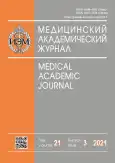Rational selection of hemagglutinin variants of H3N2 influenza viruses in preparation of live influenza vaccine strains to optimize growth characteristics
- Authors: Stepanova E.A.1, Bazhenova E.A.1, Krutikova E.V.1, Larionova N.V.1, Kiseleva I.V.1, Rudenko L.G.1
-
Affiliations:
- Institute of Experimental Medicine
- Issue: Vol 21, No 3 (2021)
- Pages: 141-146
- Section: Conference proceedings
- Published: 06.12.2021
- URL: https://journals.eco-vector.com/MAJ/article/view/77445
- DOI: https://doi.org/10.17816/MAJ77445
- ID: 77445
Cite item
Abstract
BACKGROUND: Up to date Russian live attenuated influenza vaccines are produced in developing chicken embryos. During passaging in embryos, the virus isolated from the human respiratory tract undergoes adaptation to the receptors in embryos. The population of the virus, at any passage in chicken embryos, is heterogeneous and contains variants of viruses with one or another set of adaptive substitutions. Before preparing the vaccine strain, the population of the epidemic virus is cloned and the genetic sequence of the hemagglutinin and neuraminidase clones is analyzed. The growth characteristics of the vaccine strain and its antigenic properties depend on the correct choice of the variant of the virus.
AIM: The aim of the study was to select the variant of the H3N2 subtype virus for the preparation of a vaccine reassortant based on data on the composition of the population and an assessment of its growth properties.
MATERIALS AND METHODS: Viruses were cloned in developing chicken embryos, sequencing of the hemagglutinin and neuraminidase genes of the clones was performed. On the basis of the clones selected based on the results of the analysis of the population, strains of a live influenza vaccine were obtained by the reassortment in the chicken embryos. The growth characteristics of the strains, the phenotype in eggs, and the antigenic properties by hemagglutination inhibition test were evaluated.
RESULTS: The influenza virus A/Kansas/14/2017 recommended by WHO for the epidemic season 2019-2020 acquired a pair of D190N + N246T substitutions dominating in the population at the 7th passage in eggs. From the population of A/Kansas/14/2017-like strain A/Brisbane/34/2018, from the third passage in the eggs, it was possible to obtain a variant of the virus with substitutions G186V + S219Y in hemagglutinin. The growth characteristics of the strain based on A/Kansas/14/2017 (passage E7) were significantly inferior to the characteristics of the strain based on A/Brisbane/34/2018 (passage E3), in the absence of differences in antigenic properties.
CONCLUSIONS: The variant of egg adaptation of hemagglutinin G186V in strains of clade 3c.3a is preferable for the preparation of live influenza vaccine strains; variant N246T is not optimal. When preparing strains, it is necessary to analyze the composition of the virus population by cloning and choose the most optimal option for preparing strains. The persistence of egg-adaptive substitutions in passaged variants of the virus is not always optimal for strains of live influenza vaccine, and therefore it is preferable to use the population as close as possible to the initial variant to start work on the strain.
Full Text
About the authors
Ekaterina A. Stepanova
Institute of Experimental Medicine
Author for correspondence.
Email: fedorova.iem@gmail.com
ORCID iD: 0000-0002-8670-8645
SPIN-code: 8010-3047
Cand. Sci. (Biol.), Senior Researcher
Russian Federation, Saint PetersburgEkaterina A. Bazhenova
Institute of Experimental Medicine
Email: sonya.01.08@mail.ru
ORCID iD: 0000-0003-3280-556X
SPIN-code: 5169-1426
Cand. Sci. (Biol.), Senior Researcher
Russian Federation, Saint PetersburgElena V. Krutikova
Institute of Experimental Medicine
Email: krutikova.iem@gmail.com
ORCID iD: 0000-0002-0383-2625
SPIN-code: 6330-6128
Cand. Sci. (Biol.), Researcher
Russian Federation, Saint PetersburgNataliya V. Larionova
Institute of Experimental Medicine
Email: nvlarionova@mail.ru
ORCID iD: 0000-0003-1171-3383
SPIN-code: 4709-5010
Dr. Sci. (Biol.), Leading Researcher
Russian Federation, Saint PetersburgIrina V. Kiseleva
Institute of Experimental Medicine
Email: irina.v.kiseleva@mail.ru
ORCID iD: 0000-0002-3892-9873
SPIN-code: 7857-7306
Dr. Sci. (Biol.), Professor, Head of the Laboratory
Russian Federation, Saint PetersburgLarisa G. Rudenko
Institute of Experimental Medicine
Email: vaccine@mail.ru
ORCID iD: 0000-0002-0107-9959
SPIN-code: 4181-1372
Dr. Sci. (Med.), Professor, Honored Scientist of the Russian Federation
Russian Federation, Saint PetersburgReferences
- Recommended composition of influenza virus vaccines for use in the 2019–2020 northern hemisphere influenza season [Internet]. WHO. Available from: https://www.who.int/influenza/vaccines/virus/recommendations/2019_20_north/en/. Accessed: 28.08.2021.
- Gouma S, Weirick M, Hensley SE. Antigenic assessment of the H3N2 component of the 2019-2020 Northern Hemisphere influenza vaccine. Nat Commun. 2020;11(1):2445. doi: 10.1038/s41467-020-16183-y
- Tate MD, Job ER, Deng YM, et al. Playing hide and seek: how glycosylation of the influenza virus hemagglutinin can modulate the immune response to infection. Viruses. 2014;6(3):1294–1316. doi: 10.3390/v6031294
Supplementary files







